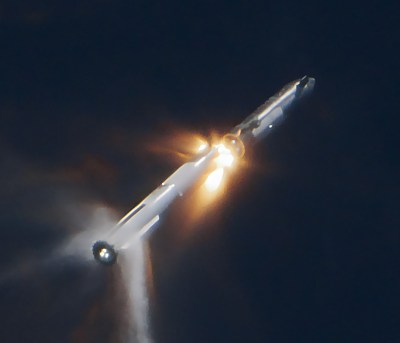
Two RUDs are better than one, right? That might be the line on Saturday morning’s briefly spectacular second attempt by SpaceX to launch their Starship vehicle atop a Super Heavy booster, which ended with the “rapid unscheduled disassembly” of both vehicles. The first attempt, back in April, had trouble from the get-go, including the rapid unscheduled partial disassembly of their Stage Zero launch pad, followed by rapid but completely predictable disassembly of a lot of camera gear and an unfortunate minivan thanks to flying chunks of concrete.

Engineering changes helped keep Stage Zero more or less intact this time, and the Super Heavy booster performed flawlessly — for about three minutes. It was at that point, right after the start of the new “hot staging” process, where Starship’s six engines light before the booster actually drops away, that the problems started. The booster made a rapid flip maneuver to get into the correct attitude for burn-back and landing before disappearing in a massive ball of flame.
Reports are that the flight termination system did the deed, but it’s not yet exactly clear why. Ditto the Starship, which was also snuffed by the FTS after continuing to fly for about another five minutes. Still in all, the SpaceX crew seem to be ecstatic about the results, which is understandable for a company with a “move fast, break things” culture. Nailed it.
As a professional YouTube watcher — not YouTuber; big difference — it’s hard to escape the impression lately that the video-sharing service really, really doesn’t like me. For the last couple of weeks I’ve been inundated with nasty pop-ups of escalating aggression indicating YouTube’s displeasure with the presence of the uBlock Origin extension on my browser. How it discerns that fact — which isn’t changing, by the way — may now be getting the company into hot water with EU regulators, who are fielding complaints that scripts to detect ad blockers constitute illegal spyware. The complaint originates from a privacy consultant in Ireland, which has its own privacy laws on top of EU rules, and claims that the software is deployed on users’ machines without their knowledge or consent. Color us cynical, but we’re pretty sure this will go nowhere, and we who have no choice but to continue using YouTube will be in a constant state of war with the service as it attempts to keep The Spice flowing.
From the “You get paid for doing this?” files, a new scientific paper reveals that virtual meetings are more fatiguing than in-person meetings. The peer-reviewed paper, published in the Journal of Occupational Health Psychology, does make an interesting distinction between “active fatigue,” which they classify as exhaustion due to overloading demands, and “passive fatigue,” which stems from a lack of stimulation. Most of us can probably relate to the difference; there’s a world of difference between being tired at the end of the day because you were absolutely swamped with work, and spending a day having your soul sucked out of you through your webcam. To their credit, the researchers did make every effort at objective measures of fatigue, like heart rate analysis of test subjects. They also did “time-stamped field observations,” which consisted of someone shadowing test subjects during their workdays and attending both IRL and virtual meetings with them to watch for signs of fatigue. Imagine having to go to someone else’s meetings and count the number of times they yawn. Being a grad student sucks.
We’ve never been to Tulsa, Oklahoma, but now that we’ve learned that there’s a “physics-defying” auditory anomaly there, we’re still reasonably sure we won’t be going there anytime soon. Which is too bad, because the accidental phenomenon actually seems pretty cool. It occurs on a pedestrian bridge, where a circular plaza with a tripping hazard low wall of curved planters reflects sound back to the center of the circle. Stand at the center of the circle and you hear an echo of your own voice; stand outside the planters, and nobody can hear you, at least not very well. The “Center of the Universe,” as it’s known, has become a minor tourist attraction, which has the city of Tulsa looking into improvements to make the auditory effect more pronounced. And with all due respect to Tulsans, the place could use a little sprucing up — looks a little dumpy.
And finally, the Geerling boys are back at it, this time with a tour of an AM radio transmitter facility. Having already looked at a “supertower” site hosting multiple FM and TV stations, their attention this time turns to KMOX, a 50,000-watt flamethrower in Missouri that has been on the air pretty much as long as there’s been radio. To a radio geek, the tour is fascinating, especially details like the ceramic insulator that bears the entire weight of the tower, the web of counterpoise wires spread out in the ground under the tower, and the many ways all that blistering RF energy is generated and contained. Also interesting was the relatively recent addition of hardened “station-in-a-box” facilities, which we discussed recently in our Radio Apocalypse series. The senior Geerling has been in the radio business for decades and really knows his stuff, so there are tons of little tidbits that any radio buff is sure to enjoy.
Hackaday Links: November 19, 2023
Source: Manila Flash Report
0 Comments